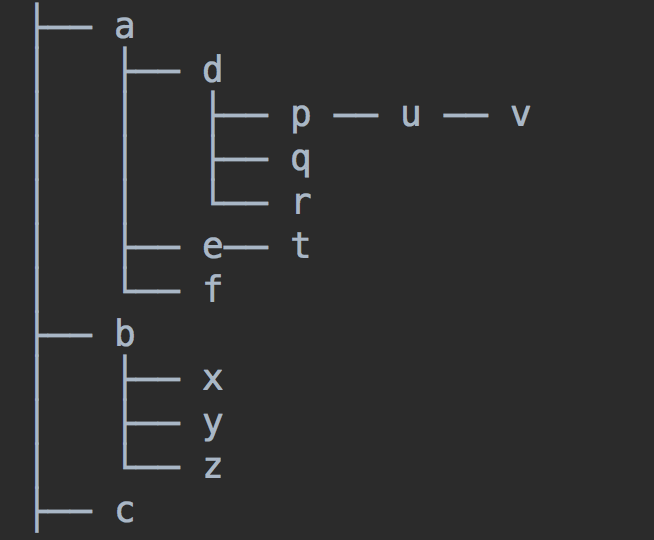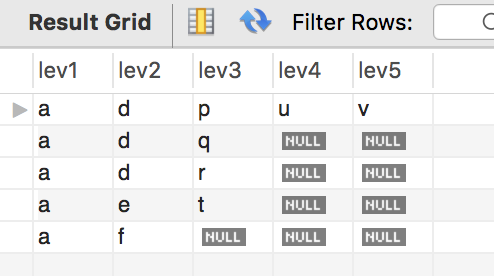背景:部门产品存在 文件夹树形结构的功能,但原来的设计 对于文件夹树的获取 需要遍历 进行IO 查询,存在性能瓶颈,探索非遍历方案获取树形结构,性能调优。
树结构如下:

查询节点为 p,已知 p 节点id,探究 分别 查询 p 节点的 父节点,祖父节点,子节点,子孙节点的 复杂程度, 以及节点移动(p移动到b 节点下面)、节点删除(删除p节点,p节点子节点跟进,为d的子节点)、节点新增(p节点添加子节点 w)
原设计方案(Adjacency list 邻接表):
每一条记录存parent_id
- 表结构:
CREATE TABLE `folder` (
`id` int(11) NOT NULL AUTO_INCREMENT COMMENT '主键id,自增',
`folderName` varchar(100) NOT NULL COMMENT '文件名',
`parentId` int(11) NOT NULL COMMENT '父节点id',
PRIMARY KEY (`id`),
INDEX `idx_parent_id` (`parentId` ASC)
) ENGINE=InnoDB DEFAULT CHARSET=utf8mb4 COMMENT = '文件夹表';
1
2
3
4
5
6
7
2
3
4
5
6
7
- 测试数据
INSERT INTO `folder` (id,folderName,parentId)VALUES (1,'a',0);
INSERT INTO `folder` (id,folderName,parentId)VALUES (2,'b',0);
INSERT INTO `folder` (id,folderName,parentId)VALUES (3,'c',0);
INSERT INTO `folder` (id,folderName,parentId)VALUES (4,'d',1);
INSERT INTO `folder` (id,folderName,parentId)VALUES (5,'e',1);
INSERT INTO `folder` (id,folderName,parentId)VALUES (6,'f',1);
INSERT INTO `folder` (id,folderName,parentId)VALUES (7,'x',2);
INSERT INTO `folder` (id,folderName,parentId)VALUES (8,'y',2);
INSERT INTO `folder` (id,folderName,parentId)VALUES (9,'z',2);
INSERT INTO `folder` (id,folderName,parentId)VALUES (10,'p',4);
INSERT INTO `folder` (id,folderName,parentId)VALUES (11,'q',4);
INSERT INTO `folder` (id,folderName,parentId)VALUES (12,'r',4);
INSERT INTO `folder` (id,folderName,parentId)VALUES (13,'t',5);
INSERT INTO `folder` (id,folderName,parentId)VALUES (14,'u',10);
INSERT INTO `folder` (id,folderName,parentId)VALUES (15,'v',14);
1
2
3
4
5
6
7
8
9
10
11
12
13
14
15
2
3
4
5
6
7
8
9
10
11
12
13
14
15
- 查询语句
p 节点的父节点
select * from folder where id=(select parentId from folder where id=10);
p 节点 祖父节点
DROP FUNCTION IF EXISTS `getParentList`;
DELIMITER //
CREATE FUNCTION `getParentList`(rootId varchar(100))
RETURNS varchar(1000)
BEGIN
DECLARE fid varchar(100) default '';
DECLARE str varchar(1000) default rootId;
WHILE rootId is not null do
SET fid =(SELECT parentId FROM folder WHERE id = rootId);
IF fid is not null THEN
SET str = concat(str, ',', fid);
SET rootId = fid;
ELSE
SET rootId = fid;
END IF;
END WHILE;
return str;
END //
DELIMITER ;
select * from folder where FIND_IN_SET(id,getParentList(10))
1
2
3
4
5
6
7
8
9
10
11
12
13
14
15
16
17
18
19
20
2
3
4
5
6
7
8
9
10
11
12
13
14
15
16
17
18
19
20
p 节点 子节点
select * from folder where parentId=10;
p 节点 子孙节点
`DROP FUNCTION IF EXISTS `getChildList`;
DELIMITER //
CREATE FUNCTION `getChildList`(rootId INT)
RETURNS varchar(1000) READS SQL DATA
BEGIN
DECLARE sTemp VARCHAR(1000);
DECLARE sTempChd VARCHAR(1000);
SET sTemp = '$';
SET sTempChd =cast(rootId as CHAR);
WHILE sTempChd is not null DO
SET sTemp = concat(sTemp,',',sTempChd);
SELECT group_concat(id) INTO sTempChd FROM folder where FIND_IN_SET(parentId,sTempChd)>0;
END WHILE;
RETURN sTemp;
END //
DELIMITER ;
select *from folder where find_in_set(id, getChildList(10));
1
2
3
4
5
6
7
8
9
10
11
12
13
14
15
16
17
2
3
4
5
6
7
8
9
10
11
12
13
14
15
16
17
- 节点新增(p节点添加子节点 w)
INSERT INTO folder (folderName,parentId)VALUES ('w',10); - 节点移动(p移动到b 节点下面,p 节点子孙节点跟随)
UPDATE folder f, ( SELECT * FROM folder WHERE folderName = 'b' ) temp
SET f.parentId = temp.id
WHERE f.id = 10;
1
2
3
2
3
- 节点删除(删除p节点,p节点子节点 u 跟进,为d的子节点)
update folder f,(select * from folder where folderName='p') temp
set f.parentId=temp.parentId
where f.parentId=10;
delete from folder where id=10;
1
2
3
4
2
3
4
- 获取整棵树结构(需要知道 树 层级结构)
SELECT t1.folderName AS lev1, t2.folderName as lev2, t3.folderName as lev3, t4.folderName as lev4,t5.folderName as lev5
FROM folder AS t1
LEFT JOIN folder AS t2 ON t2.parentId = t1.id
LEFT JOIN folder AS t3 ON t3.parentId = t2.id
LEFT JOIN folder AS t4 ON t4.parentId = t3.id
LEFT JOIN folder AS t5 ON t5.parentId = t4.id
WHERE t1.folderName = 'a';
1
2
3
4
5
6
7
2
3
4
5
6
7

路径表(Path Enumeration)
每一条记录存整个tree path经过的node枚举
- 表结构:
CREATE TABLE `path_folder` (
`id` INT(11) NOT NULL AUTO_INCREMENT COMMENT '主键id,自增',
`folderName` VARCHAR(100) NOT NULL COMMENT '文件夹名称',
`path` VARCHAR(200) NOT NULL COMMENT '路径',
`parentId` INT(11) NOT NULL DEFAULT 0 COMMENT '父节点id'
PRIMARY KEY (`id`))
ENGINE = InnoDB
DEFAULT CHARSET = utf8mb4
COMMENT = '路径文件夹表';
1
2
3
4
5
6
7
8
9
2
3
4
5
6
7
8
9
- 测试数据
INSERT INTO `path_folder` (id,folderName,path,parentId)VALUES (1,'a','/0',0);
INSERT INTO `path_folder` (id,folderName,path,parentId)VALUES (2,'b','/0',0);
INSERT INTO `path_folder` (id,folderName,path,parentId)VALUES (3,'c','/0',0);
INSERT INTO `path_folder` (id,folderName,path,parentId)VALUES (4,'d','/1',1);
INSERT INTO `path_folder` (id,folderName,path,parentId)VALUES (5,'e','/1',1);
INSERT INTO `path_folder` (id,folderName,path,parentId)VALUES (6,'f','/1',1);
INSERT INTO `path_folder` (id,folderName,path,parentId)VALUES (7,'x','/2',2);
INSERT INTO `path_folder` (id,folderName,path,parentId)VALUES (8,'y','/2',2);
INSERT INTO `path_folder` (id,folderName,path,parentId)VALUES (9,'z','/2',2);
INSERT INTO `path_folder` (id,folderName,path,parentId)VALUES (10,'p','/1/4',4);
INSERT INTO `path_folder` (id,folderName,path,parentId)VALUES (11,'q','/1/4',4);
INSERT INTO `path_folder` (id,folderName,path,parentId)VALUES (12,'r','/1/4',4);
INSERT INTO `path_folder` (id,folderName,path,parentId)VALUES (13,'t','/1/5',5);
INSERT INTO `path_folder` (id,folderName,path,parentId)VALUES (14,'u','/1/4/10',10);
INSERT INTO `path_folder` (id,folderName,path,parentId)VALUES (15,'v','/1/4/10/14',14);
1
2
3
4
5
6
7
8
9
10
11
12
13
14
15
2
3
4
5
6
7
8
9
10
11
12
13
14
15
- 查询语句
- p 节点的父节点
select * from path_folder where id=(select parentId from path_folder where id=10);
- p 节点 祖父节点
SELECT *
FROM path_folder
WHERE id IN (
SELECT substring_index(substring_index(t.path, '/', b.help_topic_id + 1), '/', -1)
FROM path_folder t
JOIN mysql.help_topic b ON b.help_topic_id < LENGTH(t.path) - LENGTH(REPLACE(t.path, '/', '')) + 1
WHERE id = 10
);
1
2
3
4
5
6
7
8
2
3
4
5
6
7
8
- p 节点 子节点
select * from path_folder where parentId=10;
1
- p 节点 子孙节点
SELECT * FROM path_folder
WHERE path LIKE '%/10%';
1
2
2
- 节点新增(p节点添加子节点 w)
INSERT INTO path_folder (folderName, path, parentId)
SELECT 'w', concat((
SELECT path
FROM path_folder
WHERE id = 10
), '/10'), 10;
1
2
3
4
5
6
2
3
4
5
6
- 节点移动(p移动到b 节点下面,p 节点子孙节点跟随)
UPDATE path_folder pf, (
SELECT *
FROM path_folder
WHERE folderName = 'b'
) b, (
SELECT *
FROM path_folder
WHERE id = 10
) p
SET pf.path = replace(pf.path, p.path, concat(if(b.path = '/0', '', b.path), '/', b.id))
WHERE pf.path LIKE concat('%', p.path, '/%')
OR pf.id = 10;
UPDATE path_folder f, ( SELECT * FROM path_folder WHERE folderName = 'b' ) temp
SET f.parentId = temp.id
WHERE f.id = 10;
1
2
3
4
5
6
7
8
9
10
11
12
13
14
15
2
3
4
5
6
7
8
9
10
11
12
13
14
15
- 节点删除(删除p节点,p节点子节点 u 跟进,为d的子节点)
update path_folder f,(select * from path_folder where folderName='p') temp
set f.parentId=temp.parentId
where f.parentId=10;
update path_folder
set path=replace(path,'/10','')
where path like "%/10%";
delete from folder where id=10;
1
2
3
4
5
6
7
2
3
4
5
6
7
嵌套集(Nested Sets)
每一条记录存 nleft 和 nright 此处不适合当前业务,故不展开讨论,附相关博客地址,有需求可自行参考
树形结构的数据库表Schema设计
基于左右值编码的树形数据库表结构设计
在MySQL中存储树状结构
路径表(Closure Table)
维护一个表,所有的tree path作为记录进行保存
- 表结构
CREATE TABLE `closure_path` (
`id` INT(11) NOT NULL AUTO_INCREMENT COMMENT '主键id,自增',
`folderName` VARCHAR(100) NOT NULL COMMENT '文件夹名称',
PRIMARY KEY (`id`))
ENGINE = InnoDB
DEFAULT CHARACTER SET = utf8mb4
COMMENT = '路径表';
CREATE TABLE `closure_path_relation` (
`id` INT NOT NULL AUTO_INCREMENT COMMENT '主键id,自增',
`ancestor` INT(1) NOT NULL COMMENT '祖先id',
`descendant` INT(11) NOT NULL COMMENT '后裔',
`isLeaf` TINYINT(11) NOT NULL COMMENT '是否为叶子节点',
`depth` INT(6) NOT NULL DEFAULT 0 COMMENT '深度',
PRIMARY KEY (`id`))
ENGINE = InnoDB
DEFAULT CHARACTER SET = utf8mb4
COMMENT = '路径关系表';
1
2
3
4
5
6
7
8
9
10
11
12
13
14
15
16
17
18
19
2
3
4
5
6
7
8
9
10
11
12
13
14
15
16
17
18
19
- 测试数据
INSERT INTO `closure_path` (id,folderName)VALUES (1,'a');
INSERT INTO `closure_path` (id,folderName)VALUES (2,'b');
INSERT INTO `closure_path` (id,folderName)VALUES (3,'c');
INSERT INTO `closure_path` (id,folderName)VALUES (4,'d');
INSERT INTO `closure_path` (id,folderName)VALUES (5,'e');
INSERT INTO `closure_path` (id,folderName)VALUES (6,'f');
INSERT INTO `closure_path` (id,folderName)VALUES (7,'x');
INSERT INTO `closure_path` (id,folderName)VALUES (8,'y');
INSERT INTO `closure_path` (id,folderName)VALUES (9,'z');
INSERT INTO `closure_path` (id,folderName)VALUES (10,'p');
INSERT INTO `closure_path` (id,folderName)VALUES (11,'q');
INSERT INTO `closure_path` (id,folderName)VALUES (12,'r');
INSERT INTO `closure_path` (id,folderName)VALUES (13,'t');
INSERT INTO `closure_path` (id,folderName)VALUES (14,'u');
INSERT INTO `closure_path` (id,folderName)VALUES (15,'v');
INSERT INTO `closure_path_relation` (ancestor,descendant,isLeaf,depth)VALUES (1,1,0,0);
INSERT INTO `closure_path_relation` (ancestor,descendant,isLeaf,depth)VALUES (2,2,0,0);
INSERT INTO `closure_path_relation` (ancestor,descendant,isLeaf,depth)VALUES (3,3,0,0);
INSERT INTO `closure_path_relation` (ancestor,descendant,isLeaf,depth)VALUES (4,4,0,0);
INSERT INTO `closure_path_relation` (ancestor,descendant,isLeaf,depth)VALUES (5,5,0,0);
INSERT INTO `closure_path_relation` (ancestor,descendant,isLeaf,depth)VALUES (6,6,0,0);
INSERT INTO `closure_path_relation` (ancestor,descendant,isLeaf,depth)VALUES (7,7,0,0);
INSERT INTO `closure_path_relation` (ancestor,descendant,isLeaf,depth)VALUES (8,8,0,0);
INSERT INTO `closure_path_relation` (ancestor,descendant,isLeaf,depth)VALUES (9,9,0,0);
INSERT INTO `closure_path_relation` (ancestor,descendant,isLeaf,depth)VALUES (10,10,0,0);
INSERT INTO `closure_path_relation` (ancestor,descendant,isLeaf,depth)VALUES (11,11,0,0);
INSERT INTO `closure_path_relation` (ancestor,descendant,isLeaf,depth)VALUES (12,12,0,0);
INSERT INTO `closure_path_relation` (ancestor,descendant,isLeaf,depth)VALUES (13,13,0,0);
INSERT INTO `closure_path_relation` (ancestor,descendant,isLeaf,depth)VALUES (14,14,0,0);
INSERT INTO `closure_path_relation` (ancestor,descendant,isLeaf,depth)VALUES (15,15,0,0);
INSERT INTO `closure_path_relation` (ancestor,descendant,isLeaf,depth)VALUES (1,4,0,1);
INSERT INTO `closure_path_relation` (ancestor,descendant,isLeaf,depth)VALUES (1,5,0,1);
INSERT INTO `closure_path_relation` (ancestor,descendant,isLeaf,depth)VALUES (1,6,1,1);
INSERT INTO `closure_path_relation` (ancestor,descendant,isLeaf,depth)VALUES (1,10,0,2);
INSERT INTO `closure_path_relation` (ancestor,descendant,isLeaf,depth)VALUES (1,11,0,2);
INSERT INTO `closure_path_relation` (ancestor,descendant,isLeaf,depth)VALUES (1,12,0,2);
INSERT INTO `closure_path_relation` (ancestor,descendant,isLeaf,depth)VALUES (1,13,1,2);
INSERT INTO `closure_path_relation` (ancestor,descendant,isLeaf,depth)VALUES (1,14,0,3);
INSERT INTO `closure_path_relation` (ancestor,descendant,isLeaf,depth)VALUES (1,15,1,4);
INSERT INTO `closure_path_relation` (ancestor,descendant,isLeaf,depth)VALUES (2,7,1,1);
INSERT INTO `closure_path_relation` (ancestor,descendant,isLeaf,depth)VALUES (2,8,1,1);
INSERT INTO `closure_path_relation` (ancestor,descendant,isLeaf,depth)VALUES (2,9,1,1);
INSERT INTO `closure_path_relation` (ancestor,descendant,isLeaf,depth)VALUES (5,13,1,1);
INSERT INTO `closure_path_relation` (ancestor,descendant,isLeaf,depth)VALUES (4,10,0,1);
INSERT INTO `closure_path_relation` (ancestor,descendant,isLeaf,depth)VALUES (4,11,1,1);
INSERT INTO `closure_path_relation` (ancestor,descendant,isLeaf,depth)VALUES (4,12,1,1);
INSERT INTO `closure_path_relation` (ancestor,descendant,isLeaf,depth)VALUES (4,14,0,2);
INSERT INTO `closure_path_relation` (ancestor,descendant,isLeaf,depth)VALUES (4,15,1,4);
INSERT INTO `closure_path_relation` (ancestor,descendant,isLeaf,depth)VALUES (10,14,0,1);
INSERT INTO `closure_path_relation` (ancestor,descendant,isLeaf,depth)VALUES (10,15,1,2);
INSERT INTO `closure_path_relation` (ancestor,descendant,isLeaf,depth)VALUES (14,15,1,1);
1
2
3
4
5
6
7
8
9
10
11
12
13
14
15
16
17
18
19
20
21
22
23
24
25
26
27
28
29
30
31
32
33
34
35
36
37
38
39
40
41
42
43
44
45
46
47
48
49
50
51
2
3
4
5
6
7
8
9
10
11
12
13
14
15
16
17
18
19
20
21
22
23
24
25
26
27
28
29
30
31
32
33
34
35
36
37
38
39
40
41
42
43
44
45
46
47
48
49
50
51
- 查询语句
- p 节点的父节点
select * from closure_path
where id in(
select ancestor from closure_path_relation
where descendant=10 and depth=1);
1
2
3
4
2
3
4
- p 节点 祖父节点
select * from closure_path
where id in(
select ancestor from closure_path_relation
where descendant=10 and depth!=0);
1
2
3
4
2
3
4
- p 节点 子节点
select * from closure_path
where id in(
select descendant from closure_path_relation
where ancestor=10 and depth=1);
1
2
3
4
2
3
4
- p 节点 子孙节点
select * from closure_path
where id in(
select descendant from closure_path_relation
where ancestor=10 and depth!=0);
1
2
3
4
2
3
4
- 节点新增(p节点添加子节点 w)
insert into closure_path(folderName) values('w');
insert into closure_path_relation(ancestor,descendant,isLeaf,depth)
select ancestor,(select id from closure_path where folderName ='w'),1,(depth+1) from closure_path_relation
where descendant=10;
insert into closure_path_relation(ancestor,descendant,isLeaf,depth)
select id,id,1,0 from closure_path
where folderName='w';
1
2
3
4
5
6
7
2
3
4
5
6
7
节点移动(p移动到b 节点下面,p 节点子孙节点跟随) // todo 待添加
节点删除(删除p节点,p节点子节点 u 跟进,为d的子节点)
update closure_path_relation
set depth=depth-1
where descendant in(select descendant from (select descendant from closure_path_relation
where ancestor=10)temp);
delete from closure_path_relation
where descendant=10 or ancestor=10;
delete from closure_path
where id=20;
1
2
3
4
5
6
7
8
2
3
4
5
6
7
8
advantage && disvantage
